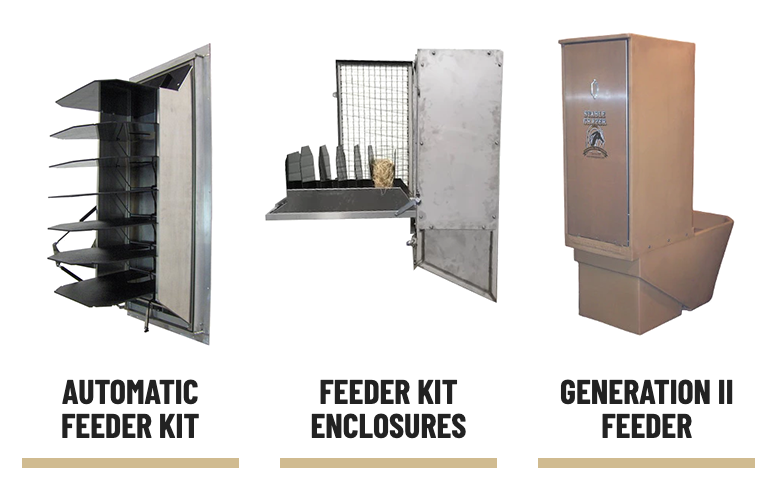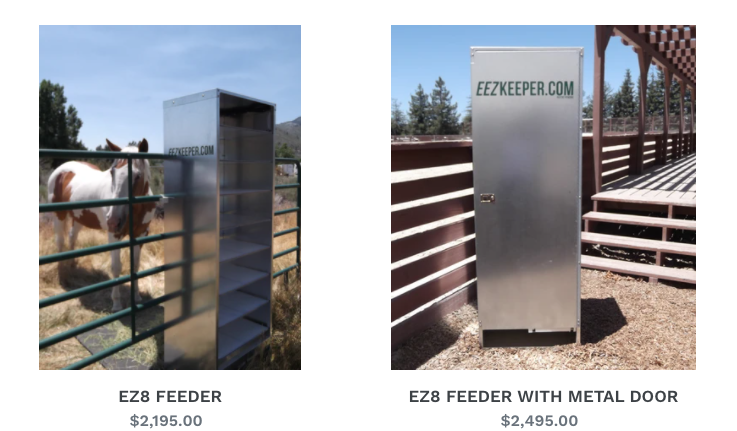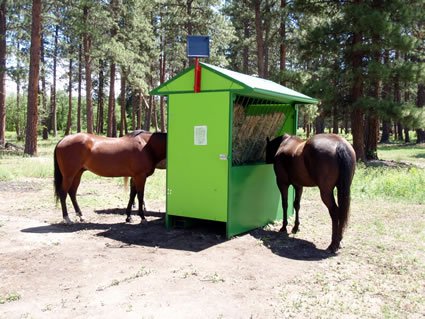3 Arguments for Automated Hay Feeders
- On Course Equine Nutrition
- Mar 7, 2022
- 5 min read
Updated: Dec 2, 2024
*At first glance, the automated hay flake feeders may appear difficult and expensive, but after digging into these further, I'm convinced that they could be a great option for many more horses suffering from or at-risk for ulcers, metabolic disease, aggression and more. Consider the following arguments and take a look at how your options compare!

ARGUMENT #1: UBIQUITY OF ULCERS
Equine gastric ulcers are everywhere- in every discipline, every region of the country, and every management style. Increasing the number of hours chewing long stem fiber is the first and most important step towards effective long-term prevention of gastric ulcers. ENTER, the seemingly infinite variety of slow feeder hay nets and other devices on the market today! Slow feed hay nets have many advantages. They are inexpensive, readily available, and do not require directions to use. However, they are not ideal for every situation and come with their own set of challenges (Read OCEN's "The Six Dangers of Slow Feed Hay Nets"? The number of frustrated slow feed hay net users led me to deep deeper into auto hay feeders. My interest was further peaked after a client purchased one, set it up, and started enjoying the glorious benefits of a much happier mare. They were the perfect candidates for auto hay feeders; single horse in confinement, a history of gastric ulcers, owner was away at work all day, and the horse was fed less than 2% of body weight in alfalfa hay. The horse did best on alfalfa hay, but feeding so little of it left her stomach empty for too many hours each day and alfalfa hay doesn't always work well in slow feed hay nets.
The physical, mental and digestive benefits of feeding multiple meals to our horses can not be understated. It is physically beneficial for the lining of the digestive tract to have long stem fiber (aka roughage) in the system at all times. We call this "scratch factor" in nutritionist lingo which simply refers to the stimulation of the digestive tract from "scratchy" fiber sources. It's also mentally beneficial for horses to have something to chew throughout the day. Finally, it's better for your horse's posture and respiratory system to feed with head down. Most of the automated hay feeders allow for this. All in all, many of the physical and mental frustrations of slow feed hay nets are avoided with automated hay feeders.

ARGUMENT #2: THE TORTURE OF MANAGING METABOLIC DISEASE
Managing overweight, insulin resistance, EMS or Cushinoid horses is torture. Not only is it torture on the bank account and the body, but it's mentally torturous to watch our beloved animals be hungry all day! Limiting a metabolic horses' total carbohydrate and caloric intake each day could be a life or death situation, but it's so hard NOT to throw them a flake when they stare at you all day long through the fence. [If we don't, then WE develop ulcers!] As I mentioned above, slow feed hay nets have been one of the few ways in which we could limit intake while increasing time chewing, which has been a god send. But now, with better understanding of hay net whoas, we should be giving these auto hay feeders another look.
Automated hay feeders have an extremely HIGH convenience rating! It's hard to manage "easy keeper", because we have to place so many restrictions on their diet! Restrictions such as running home from work on lunch break to bring in the easy keepers, placing and removing grazing muzzles, and or refilling hay nets is terribly taxing. If you're tired of refilling slow feed hay nets day in and day out, then maybe an automated hay feeder is a game changer! These auto-hay feeders can be a tremendous time and labor saver!!!
ARGUMENT #3: COST COMPARISON
An ounce of prevention is worth a pound of cure, right! This is actually true in the prevention of ulcers and laminitis. If you add up the costs of a $60 per month ulcer prevention supplement plus a 28 day round of omeprazole (1,250 horse, 1x $40 tube per day), that's nearly $1,200 in the first month. Then, what if the horse relapses and you end up doing another round of omeprazole- now you're over 2 grand into ulcer prevention and treatment. It makes the $2,500 one time cost and 1 day of labor setting it up, not seem so daunting.
What about those of us who feed an ulcer preventative supplement all year long? Now, if we consider the average preventative supplement to be about $60 per month and we multiply that by 12 months, we get $720 per year. It would only take you 4 years of that supplement to pay off the auto feeder's one time cost. Not to mention, the major decreased labor cost from scooping supplements and paying feeders to come 3x per day. There's literally a million scenarios that we could fathom and calculate here, but you're getting my drift.

Options and Links
-Advantages: Low labor option! Innovative grain bag option. Easier to get than other options at the moment.
-Disadvantages: Currently, wait times may be long due to shipping issues. Shipping to Montana was going to cost between $250-$450 depending on the model.
- Advantages: Easy to customize, multiple horse options, multiple power options.
- Disadvantages: Very expensive to ship.
3. EEZKeeper
- Advantages: Excellent customer service (Talk to Larry!), high weight limit, 10+ year lifespan, would cost me about $250 to ship to Montana from Alabama.
- Disadvantages: Currently, most models are out of stock, and not sold through any dealerships
I reached out to the owners of each company above to ask questions. One of my first questions was about reliability and long term functionality. I was happy to learn that their reliability is built into their simplicity. The owner at EEZKeeper said that the most common call he gets is how to set up the timer, which is a statement about how little they break down. These feeders keep working even in very cold and snowy climates. The owner at StableGrazer said that sometimes a timer, battery or gas shock may need to be replaced, but it is rare and they make it easy to order them online. Overall, my fears were laid to rest that these automated hay feeders would take continuous management.
SUMMARY
Automated hay feeders may not be for everyone, but they could be just the ticket for someone! As I mentioned above, most automated hay feeders will only work in 1 (maybe 2) horse living situations. Although I happy to learn that they do not require electrical outlets close by, they do take up quite a bit of space which may be impractical for a lot of barns. However, in my endless quest for better horse management and better nutrition through forage, I know I’m going to start recommending these more often.
Forage first decisions is a leading principle at OCEN, LLC! Most would be amazed at how often we can solve a huge variety of issues with better forage decisions; allergies, ulcers, metabolic disease, myopathy and even behavioral issues. Management and "Forage First Decisions" are keys to long term success, not 2 scoops of this or that latest supplement fad. We focus on this a lot during On Course Equine Nutrition private consultations. With this leading principle in mind, you can see why I get excited about the prospect of incorporating more auto hay feeders into more diet plans.













Comments